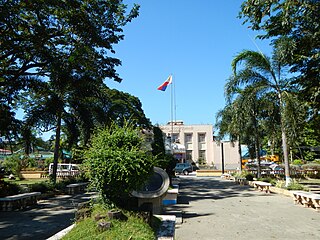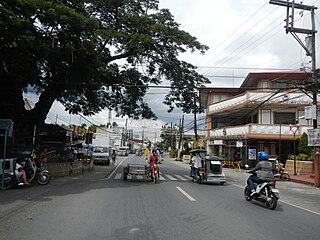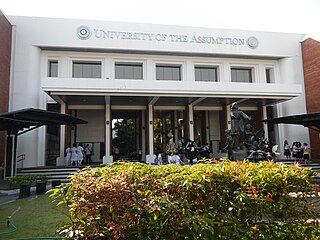
Bulacan, officially the Province of Bulacan, is a province in the Philippines located in the Central Luzon region. Its capital is the city of Malolos. Bulacan was established on August 15, 1578, and part of the Metro Luzon Urban Beltway Super Region. This province is a part of the Greater Manila Area.

Pampanga, officially the Province of Pampanga, is a province in Central Luzon in the Philippines. Lying on the northern shore of Manila Bay, Pampanga is bordered by Tarlac to the north, Nueva Ecija to the northeast, Bulacan to the east, Manila Bay to the central-south, Bataan to the southwest and Zambales to the west. Its capital is the City of San Fernando, the regional center of Central Luzon. Angeles City is the largest LGU, but while geographically within Pampanga, it is classified as a first-class, highly urbanized city and has been governed independently of the province since it received its charter in 1964.

Central Luzon, designated as Region III, is an administrative region in the Philippines. The region comprises seven provinces: Aurora, Bataan, Bulacan, Nueva Ecija, Pampanga, Tarlac, and Zambales; and two highly urbanized cities, Angeles and Olongapo. San Jose del Monte is the most populous city in the region. The region contains the largest plain in the country and produces most of the country's rice supply, earning itself the nickname "Rice Granary of the Philippines". It is also the region to have the most number of provinces.

Lubao, officially the Municipality of Lubao, is a municipality in the province of Pampanga, Philippines. According to the 2020 census, it has a population of 173,502 people.

Apalit, officially the Municipality of Apalit, is a municipality in the province of Pampanga, Philippines. According to the 2020 census, it has a population of 117,160 people.

Gapan, officially the City of Gapan, is a component city in the province of Nueva Ecija, Philippines. According to the 2020 census, it has a population of 122,968 people.

Cabiao, officially the Municipality of Cabiao, is a municipality in the province of Nueva Ecija, Philippines. According to the 2020 census, it has a population of 85,862 people. Cabiao is the 3rd most populous, one of the richest, and fastest growing municipality in the province, only behind Talavera and Guimba. If cities are included, the town ranks 6th.

Floridablanca, officially the Municipality of Floridablanca is a municipality in the province of Pampanga, Philippines. According to the 2020 census, it has a population of 135,542 people.

José Abad Santos y Basco was the fifth chief justice of the Supreme Court of the Philippines. He briefly served as the acting president of the Commonwealth of the Philippines and acting commander-in-chief of the Armed Forces of the Philippines during World War II, from March 1942 until his execution. Japanese forces killed him for refusing to cooperate during their occupation of the country.

Abucay, officially the Municipality of Abucay,, is a municipality in the province of Bataan, Philippines. According to the 2020 census, it has a population of 42,984 people.

San Fernando, officially the City of San Fernando, is a component city and capital of the province of Pampanga, Philippines. According to the 2020 census, it has a population of 354,666 people.

Macabebe, officially the Municipality of Macabebe, is a municipality in the province of Pampanga, Philippines. According to the 2020 census, it has a population of 78,151 people.

Mexico, officially the Municipality of Mexico, is a municipality in the province of Pampanga, the Philippines. According to the 2020 census, it has a population of 173,403 people. It was also formerly known as Nuevo México during the Spanish period.

San Luis, officially the Municipality of San Luis, is a municipality in the province of Pampanga, Philippines. According to the 2020 census, it had a population of 58,551 people.

The University of the Assumption (U.A.) is a private archdiocesan Catholic university in the City of San Fernando, Pampanga, Philippines. The University of the Assumption is the first Catholic archdiocesan university in the Philippines and in Asia. It is among the top schools in the region, based on its accredited programs, and licensure and professional examination results.

Pampanga National High School is a high school in San Fernando, Pampanga, Philippines.

Jose "Joe" Bulaon Lingad, also known by his initials JBL, was a Filipino lawyer and politician who served as governor of Pampanga from 1948 to 1951 and representative of Pampanga's 1st district from 1969 to 1972. He also became commissioner of the Bureau of Internal Revenue and Bureau of Customs then subsequently secretary of the Department of Labor and Employment. He is one of the victims of the Martial law at the hands of Ferdinand Marcos in 1980.
The Philippine Law School (PLS), founded in 1915, is a law school in the Philippines. It formerly served as the college of law of National University.

Jesus Reynaldo “Rey” Bondoc Aquino is a Filipino politician and surgeon who is the last municipal Mayor of San Fernando and its first Mayor when it became a city. He also served as Congressman for the 3rd district of Pampanga from June 30, 2004, to June 30, 2007. From 2008 to 2011, Aquino also acted as the President and chief executive officer of the Philippine Health Insurance or PhilHealth.
The COVID-19 pandemic in Central Luzon is part of the worldwide pandemic of coronavirus disease 2019 caused by severe acute respiratory syndrome coronavirus 2. The virus reached Central Luzon on March 9, 2020, when the first case of the disease was confirmed in San Jose del Monte. All provinces in the region have recorded COVID-19 cases. As of August 14, 2022. Central Luzon has 376,747 cases with 6,995 deaths.



















